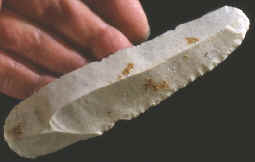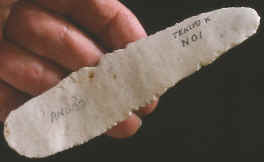|
DOUBLE
END-SCRAPER ON BLADE
UPPER
PALEOLITHIC
AURIGNACIAN--34,000-29,000
YEARS AGO
TERMO-PIALAT SITE
COUZE VALLEY, FRANCE
UNIVERSITY OF KANSAS, MUSEUM OF ANTHROPOLOGY


CAST
#AU-1
AURIGNACIAN DOUBLE END SCRAPER
ON BLADE
TERMO-PIALAT SITE
COUZE VALLEY, FRANCE
This Double End-Scraper
was found on the Termo-Pialat site in southern France. This Upper
Paleolithic Aurignacian site is located in the Couze Valley in the
Dordogne region less than a mile west of the now famous Combe-Capelle
site.
The
Aurignacian is known for its heavy use of stone tools made from blades
driven off prepared cores. This is an excellent example of a blade tool
from the Aurignacian stone tool complex. It was evidently not used very
much. There are no signs of heavy use wear and except for the initial
trimming of both ends, it was not resharpened from use. Both ends and
approximately three fourths of one edge have been trimmed with small
pressure flakes. This blade tool would have been used for either
scraping or cutting. It was made from a very good quality white chert
and measures 4 ¾ inches (12cm) long and 1 3/16 inches (3cm) wide.
The
Aurignacian stone tool complex extends over much of Europe. It dates to
the early part of the Upper Paleolithic between 34,000 and 29,000 years
ago. Aurignacian sites are known to have existed during a period of very
cold and dry climate. The Aurignacian type-site is Aurignac, which is
located in southern France in the region of Haute Garonne. |
|
References:
1973,
"Le Malpas Rockshelter", by Anta Montet-White.
1988, "Encyclopedia of Human Evolution and Prehistory", by Ian
Tattersall, Eric Delson and John Van Couvering.
|

